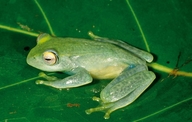|
Description
A medium-sized green treefrog. Males 31-33 mm.
Remark: This species is very similar to Boophis jaegeri in morphology. It differs
in several details of the colouration, and the call, which sounds very different. Although call features as frequency range and
note repetition rate are similar to B. jaegeri, we heard several choruses of B.
jaegeri in different months at Nosy Be and we never heard there the long call
series typical for B. andreonei. This makes it extremely unlikely that the
long call series is only a different call type of B. jaegeri.
Holotype: Adult male, ZFMK 57393, from Benavony (near Ambanja, NW-Madagascar).
SVL 31 mm, head width 11.8 mm; eye diameter 4.1 mm, tympanum indistinct,
horizontal diameter of tympanum about 1.9 mm; distance eye-nostril 2.0 mm, distance
nostril-tip of snout 3.0 mm; hand length 9.2 mm, length of foot and tarsus 21.5
mm. Tibiotarsal articulation reaches the nostril when hind leg is brought forward. Tips of fingers and toes circularly
enlarged. A distinct nuptial pad is present on the inner side of the first finger.
The tibia is clearly longer than the foot. Vomerine teeth are present.
Webbing of the hand 1(-), 2i(-), 2e(1), 3i(2), 3e(1), 4(0.75); webbing of the
foot 1(0), 2i(0.5), 2e(0), 3i(0.75), 3e(0), 4i/e(1), 5(0). Skin on the back
smooth. In life green dorsum, mottled with indistinct dark green spots. No
trace of a dorsolateral stripe. Lower arm and tarsus with yellowish white fringes. Venter whitish, ventral surface of fingertips
green. Throat and ventral surface of arms and legs greenish blue. In preservative
ventral and dorsal surface uniformly yellowish white. Iris silvery grey surrounded by orange on the outer iris area; the whole iris
irregularly reticulated with red. Posterior iris periphery light (not blue).
Dorsally the eye periphery is blue.
Paratypes: two adult males with nuptial pads (ZFMK 57391 and 57392, SVL 30.5
and 32.5, respectively) from same locality as holotype. Morphological features
and colouration very similar to the holotype.
Distribution and Habitat
Country distribution from AmphibiaWeb's database: Madagascar
Benavony, Manongarivo, Tsaratanana (Antsahamanara campsite). It occurs between 200-700 m asl in pristine and slightly degraded forest close to primary forest (Glaw and Vences 2008).
Life History, Abundance, Activity, and Special Behaviors
Calling males were found in March at night in choruses along a brook in primary
forest. Males were sitting about 2-4 m above the ground in the vegetation.
Call (from the terra typica): The call is a series of melodious notes (= pulses, see B. jaegeri), which can last for more than 10 s. Note duration is about 20 ms, intervals between notes last 25-30 ms. Note repetion rate is extremely high (about 21/s!, compare with B. jaegeri). Frequency is between 4 and 4.5 kHz.
Breeding takes place in streams (Glaw and Vences 2008).
Eggs and tadpoles: Unknown.
Trends and Threats
Vulnerable: extent of occurrence is less than 20,000 km2, its distribution is severely fragmented, and there is continuing decline in the extent and quality of its habitat in northwestern Madagascar. It occurs in the Réserve Spéciale de Manongarivo (Glaw and Vences 2008). Possible reasons for amphibian decline General habitat alteration and loss
Habitat modification from deforestation, or logging related activities
Intensified agriculture or grazing
Urbanization
Habitat fragmentation
Comments
Derivatio nominis: Dedicated to Franco Andreone, Torino, in recognition for
his contributions to the knowledge of the Malagasy anuran fauna, especially
of the Boophis luteus-group.
Taken with permission from Glaw and Vences (2007).
References
Glaw, F. and Vences, M. (1994). Amphibians and Reptiles of Madagascar. M. Vences and F. Glaw Verlags GbR., Köln.
Glaw, F. and Vences, M. (2008). Boophis andreonei. In: IUCN 2008. 2008 IUCN Red List of Threatened Species. www.iucnredlist.org. Downloaded on 08 April 2009.
Glaw, F., and Vences, M. (2007). Field Guide to the Amphibians and Reptiles of Madagascar. Third Edition. Vences and Glaw Verlag, Köln.
Originally submitted by: Miguel Vences and Frank Glaw (first posted 2000-10-24)
Edited by: Henry Zhu (2010-07-19)Species Account Citation: AmphibiaWeb 2010 Boophis andreonei <https://amphibiaweb.org/species/4331> University of California, Berkeley, CA, USA. Accessed Apr 25, 2024.
Feedback or comments about this page.
Citation: AmphibiaWeb. 2024. <https://amphibiaweb.org> University of California, Berkeley, CA, USA. Accessed 25 Apr 2024.
AmphibiaWeb's policy on data use.
| 